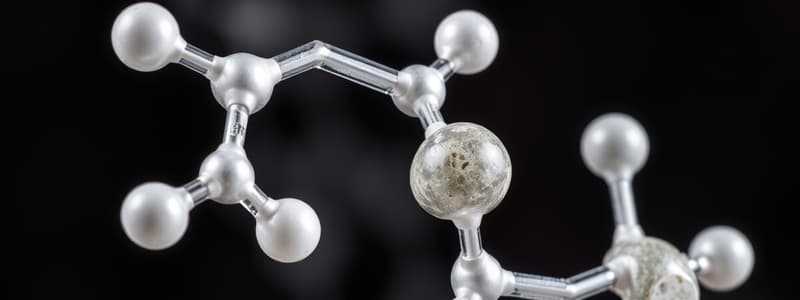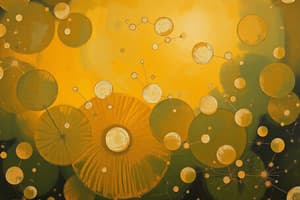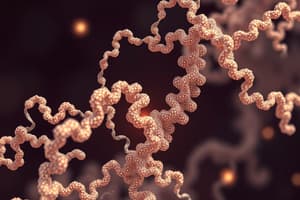Podcast
Questions and Answers
Which amino acid does not have the characteristic structure shared by all others?
Which amino acid does not have the characteristic structure shared by all others?
- Leucine
- Alanine
- Glycine
- Proline (correct)
What is the primary function of glycogen in animals?
What is the primary function of glycogen in animals?
- Storage of glucose for energy (correct)
- Structural support in cell membranes
- Transport of nutrients
- Catalysis of biochemical reactions
Which type of carbohydrate includes substances like glycoproteins?
Which type of carbohydrate includes substances like glycoproteins?
- Monosaccharides
- Oligosaccharides
- Disaccharides
- Complex carbohydrates (correct)
What is the role of glycine in the body?
What is the role of glycine in the body?
Which of the following is a major dietary disaccharide containing fructose?
Which of the following is a major dietary disaccharide containing fructose?
How does the R-group of an amino acid influence its properties?
How does the R-group of an amino acid influence its properties?
What role do proteoglycans play in biological systems?
What role do proteoglycans play in biological systems?
Which of the following statements about enzymes is accurate?
Which of the following statements about enzymes is accurate?
What is the primary function of myoglobin in muscle cells?
What is the primary function of myoglobin in muscle cells?
Which of the following best describes the structural organization of myoglobin?
Which of the following best describes the structural organization of myoglobin?
Which interaction is considered the principal force that holds protein subunits together?
Which interaction is considered the principal force that holds protein subunits together?
What happens during the denaturation of proteins?
What happens during the denaturation of proteins?
Which tissue types are primarily rich in elastin, responsible for elastic recoil?
Which tissue types are primarily rich in elastin, responsible for elastic recoil?
Which amino acid is considered nutritionally semi-essential?
Which amino acid is considered nutritionally semi-essential?
What is the primary factor stabilizing tertiary structure in proteins?
What is the primary factor stabilizing tertiary structure in proteins?
Which of the following amino acids is not an essential amino acid?
Which of the following amino acids is not an essential amino acid?
Which structural characteristic distinguishes globular proteins from fibrous proteins?
Which structural characteristic distinguishes globular proteins from fibrous proteins?
Which of the following is NOT part of the essential amino acids mnemonic 'PVT TIM HALL'?
Which of the following is NOT part of the essential amino acids mnemonic 'PVT TIM HALL'?
What defines the quaternary structure of a protein?
What defines the quaternary structure of a protein?
Which of the following is an example of a globular protein?
Which of the following is an example of a globular protein?
Which essential amino acid plays a role in the synthesis of neurotransmitters?
Which essential amino acid plays a role in the synthesis of neurotransmitters?
What type of bond is mainly responsible for the stabilization of tertiary protein structure?
What type of bond is mainly responsible for the stabilization of tertiary protein structure?
Which amino acid is required in larger amounts during periods of rapid growth?
Which amino acid is required in larger amounts during periods of rapid growth?
What is the first step in the synthesis of collagen?
What is the first step in the synthesis of collagen?
What role does vitamin C play in collagen synthesis?
What role does vitamin C play in collagen synthesis?
Which configuration of hemoglobin has a low oxygen affinity?
Which configuration of hemoglobin has a low oxygen affinity?
What is the main function of hemoglobin in red blood cells?
What is the main function of hemoglobin in red blood cells?
What is formed after procollagen is secreted from the cell?
What is formed after procollagen is secreted from the cell?
Which type of collagen is found in bones and tendons?
Which type of collagen is found in bones and tendons?
How many molecules of O2 can hemoglobin bind at maximum?
How many molecules of O2 can hemoglobin bind at maximum?
Which process involves the addition of sugars to hydroxylsine during collagen synthesis?
Which process involves the addition of sugars to hydroxylsine during collagen synthesis?
What is the predominant form of carbon dioxide transport in the blood?
What is the predominant form of carbon dioxide transport in the blood?
What is the final step in collagen synthesis?
What is the final step in collagen synthesis?
What is the role of cysteine in relation to disulfide bonds?
What is the role of cysteine in relation to disulfide bonds?
Which amino acid serves as a precursor for the synthesis of homocysteine?
Which amino acid serves as a precursor for the synthesis of homocysteine?
How do acidic amino acids like aspartate and glutamate behave at neutral pH?
How do acidic amino acids like aspartate and glutamate behave at neutral pH?
What is a significant characteristic of proline among amino acids?
What is a significant characteristic of proline among amino acids?
Which of the following amino acids contains a polar hydroxyl group?
Which of the following amino acids contains a polar hydroxyl group?
What neurotransmitter is synthesized from glutamate?
What neurotransmitter is synthesized from glutamate?
Which amino acid is described as being involved in the transfer of methyl groups?
Which amino acid is described as being involved in the transfer of methyl groups?
Which of the following accurately describes a function of niacin?
Which of the following accurately describes a function of niacin?
Which amino acid is commonly referred to as the 'helix-breaker'?
Which amino acid is commonly referred to as the 'helix-breaker'?
Which amino acids are categorized as uncharged polar amino acids?
Which amino acids are categorized as uncharged polar amino acids?
Study Notes
Amino Acids Overview
- All amino acids (except proline) have a carboxyl group, an amino group, and a distinctive side chain (R-group).
- The structure of the R-group determines the amino acid's functionality in proteins.
- Glycine is the simplest amino acid, pivotal in heme synthesis and acts as a major inhibitory neurotransmitter in the spinal cord.
Disaccharides and Polysaccharides
- Key disaccharides:
- Maltose: intermediate in starch digestion (glucose-glucose).
- Sucrose: main dietary sugar (glucose-fructose).
- Lactose: found in milk (galactose-glucose).
- Starch (plants) and glycogen (animals) are primary storage polymers of glucose.
- Complex carbohydrates include sugar derivatives like amino sugars and play a role in structural elements of tissues.
Functions of Proteins
- Proteins are linear polymers of amino acids with diverse functions:
- Catalysts for chemical reactions (enzymes).
- Transport and storage (e.g., hemoglobin).
- Coordination of motion (actin and myosin).
Key Amino Acids and Their Roles
- Methionine: major methyl group source in metabolism, involved in the transfer of methyl groups.
- Cysteine: contains sulfhydryl groups, forms disulfide bonds, essential in enzyme function and biosynthesis.
- Acidic Amino Acids: Aspartate and Glutamate are negatively charged at neutral pH, involved in ionic interactions and act as proton donors, with glutamate serving as a precursor for GABA.
Uncharged Polar Amino Acids
- Include Serine, Threonine, and Tyrosine, characterized by a polar hydroxyl group.
Essential Amino Acids
- Cannot be synthesized by the body and must be obtained through diet:
- Phenylalanine, Valine, Tryptophan, Threonine, Isoleucine, Methionine, Lysine, Leucine, Histidine, Arginine (semi-essential).
Protein Structure
- Tertiary Structure: overall 3D shape of a protein, shaped by disulfide bonds, hydrophobic interactions, and hydrogen bonds.
- Quaternary Structure: assembly of multiple polypeptide chains, stabilized by similar interactions as tertiary structure.
Collagen Synthesis and Types
- Collagen synthesis involves several critical steps including hydroxylation, glycosylation, and the formation of triple helices.
- Types of collagen:
- Type I: found in bone and tendons.
- Type II: found in cartilage.
- Type III: reticular fibers.
- Type IV: basal laminae structures.
Hemoglobin and Myoglobin
- Hemoglobin: heme protein for O2 transport in red blood cells, binds up to 4 O2 molecules, exists in T (taut) and R (relaxed) forms.
- Myoglobin: oxygen reservoir in muscle cells, consists of a single polypeptide chain, involved in O2 transport within muscle tissue.
Denaturation of Proteins
- Loss of protein's native structure (secondary, tertiary, or quaternary) leads to a loss of function.
- Denaturation can be caused by various agents that cleave non-covalent bonds.
Interactions Stabilizing Protein Structures
- Hydrophobic and electrostatic interactions, hydrogen bonds, and disulfide bonds are crucial for maintaining protein structure.
Studying That Suits You
Use AI to generate personalized quizzes and flashcards to suit your learning preferences.
Related Documents
Description
This quiz covers the fundamental structure of amino acids, highlighting their common features such as carboxyl and amino groups, and unique side chains. Additionally, it touches on important disaccharides like maltose, sucrose, and lactose relevant to carbohydrate digestion. Test your knowledge on these key biochemistry concepts!




